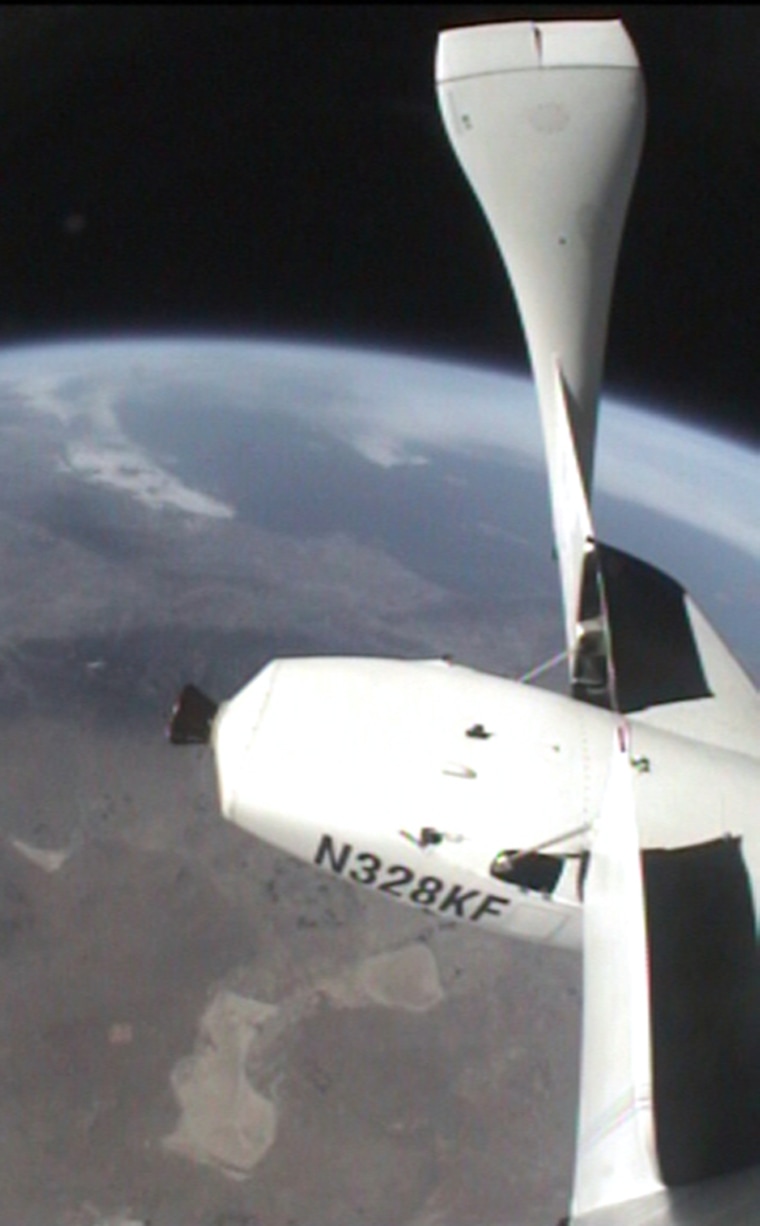Chalk up another booming flight of the privately backed SpaceShipOne, the piloted rocket plane designed to soar to the edge of space and glide to a runway landing.
With pilot Mike Melvill at the controls — following release from the White Knight turbojet-powered launch aircraft high above California's Mojave Desert — SpaceShipOne punched through the sky Thursday boosted by a hybrid propellant rocket motor.
Scaled Composites of Mojave, Calif., is the builder of SpaceShipOne, an effort led by aviation innovator Burt Rutan. The financial backer of the project is Microsoft co-founder Paul Allen. (MSNBC is a Microsoft-NBC joint venture.)
In a post-flight statement from the company, the SpaceShipOne team reported that their space plane flew to 212,000 feet altitude, almost 41 miles. NASA awards astronaut status to anyone who flies above 50 miles in altitude.
"This flight marks an additional milestone for Paul G. Allen, Burt Rutan and the innovative aerospace design team in their ongoing efforts to complete the first non-government manned space flight. The test is part of Scaled Composites' Tier One program, funded by Allen, Microsoft co-founder and CEO of Vulcan Inc.," according to the statement.
Thursday's flight builds upon a progression of 13 shakeout tests, mostly unpowered drop glides along with two engine-thrusting runs. The White Knight took off with SpaceShipOne at around 10:30 a.m. ET with the rocket plane landing an the ground a little after noon.
"The SpaceShipOne team will announce the results of this test flight once it has completed an analysis of the data," explained the Scaled Composites release, adding: "The future's looking up ... way up!"
Hot pursuit
SpaceShipOne's first powered mission took place last Dec. 17, with the hybrid motor firing for 15 seconds. A second powered flight occurred on April 8. In that trek, the motor burned for 40 seconds. A major contractor for the hybrid motor used in the rocket plane is SpaceDev of Poway, Calif.
Routine recording of multiple video streams on board White Knight and on SpaceShipOne are expected to help in pilot and engineering evaluation of the flight.
Ecliptic Enterprises Corp. of Pasadena, Calif., provides the critical camera gear. They are also supplier of the RocketCam line of onboard video systems used on rockets, spacecraft and other remote platforms.
The step-by-step SpaceShipOne missions are keyed to winning the Ansari X Prize, a $10 million purse offered by the X Prize Foundation of St. Louis. For the cash prize, however, the clock is running: The $10 million purse expires Jan. 1, 2005.
The Ansari X Prize money is to be awarded to the first company or organization to launch a vehicle capable of carrying three people to a height of 62.5 miles (100 kilometers), then return safely to Earth, and repeat the flight with the same vehicle within two weeks.
Twenty-seven teams from around the globe are vying for the Ansari X Prize contest. The competition is modeled on the $25,000 Orteig Prize — won by Charles Lindbergh after winging his Spirit of St. Louis airplane solo from New York to Paris in 1927.
Federal go-ahead
On April 1, the U.S. Department of Transportation announced that the Federal Aviation Administration had issued Scaled Composites the world's first license for a suborbital manned rocket flight.
The license came via the FAA's Office of Commercial Space Transportation. This federal paperwork gave Scaled Composites the go-ahead to fly a string of suborbital flights for a one-year period — the first license to authorize piloted flight on a suborbital trajectory.
XCOR Aerospace, also of Mojave, announced in April it had received a license for reusable launch vehicle missions from the Office of Commercial Space Transportation. That license is the first for a reusable launch vehicle that is launched and recovered from the ground. Additionally, XCOR is now authorized to test RLV technologies prior to suborbital passenger travel. The company is not in the competition for the Ansari X Prize.
XCOR's launch license is for a technology test vehicle. The license does not yet cover passenger operations. It does, however, permit revenue-generating payload flights after initial tests are completed. "A significant feature of the license is that it allows the pilot to do an incremental series of flight tests — without preplanning each trajectory," XCOR's government liaison, Randall Clague, said in a press statement.
Mojave mojo
Given all the rocket plane activity at the Mojave Airport, steps have been taken to have the facility certified as a spaceport.
Stuart Witt, general manager of the Mojave Airport, envisions the site busily handling the horizontal launchings and landings of reusable spacecraft.
Witt said the FAA's Office of Commercial Space Transportation is reviewing an application to license Mojave Airport as an inland spaceport. In fact, the airport is already a natural center for research and development and certification programs, such as the rocket plane work of Scaled Composites and XCOR Aerospace.
Many see Mojave Airport as a magical nexus for safe, smooth coordination of general aviation activity and private aerospace development.
Mojave Airport, also tagged the nation's Civilian Flight Test Center, is situated away from major metropolitan areas, while being located near the Edwards and China Lake military test ranges.
"Certainly Mojave is a premier location due to its proximity to the Edwards Air Force Base restricted areas," Burt Rutan told Space.com.
Adds Aleta Jackson, an XCOR Aerospace executive: "We look forward to flying our licensed spacecraft from the Mojave Spaceport." The town of Mojave — as well as Kern County — plan to help support the spaceport, such as designating land use that is compatible with an active spaceport, she said.
